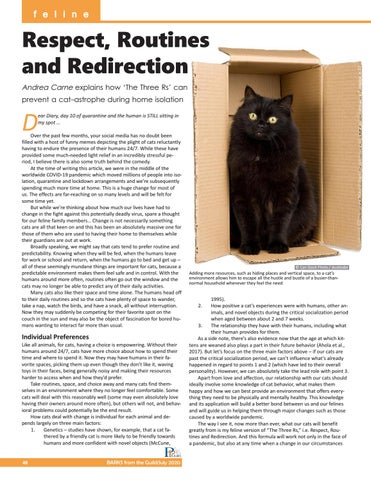f e l i n e
Respect, Routines and Redirection Andrea Carne explains how ‘The Three Rs’ can prevent a cat-astrophe during home isolation
D
ear Diary, day 10 of quarantine and the human is STILL sitting in my spot …
Over the past few months, your social media has no doubt been filled with a host of funny memes depicting the plight of cats reluctantly having to endure the presence of their humans 24/7. While these have provided some muchneeded light relief in an incredibly stressful pe riod, I believe there is also some truth behind the comedy. At the time of writing this article, we were in the middle of the worldwide COVID19 pandemic which moved millions of people into iso lation, quarantine and lockdown arrangements and we’re subsequently spending much more time at home. This is a huge change for most of us. The effects are farreaching on so many levels and will be felt for some time yet. But while we’re thinking about how much our lives have had to change in the fight against this potentially deadly virus, spare a thought for our feline family members… Change is not necessarily something cats are all that keen on and this has been an absolutely massive one for those of them who are used to having their home to themselves while their guardians are out at work. Broadly speaking, we might say that cats tend to prefer routine and predictability. Knowing when they will be fed, when the humans leave for work or school and return, when the humans go to bed and get up – all of these seemingly mundane things are important for cats, because a predictable environment makes them feel safe and in control. With the humans around more often, routines often go out the window and the cats may no longer be able to predict any of their daily activities. Many cats also like their space and time alone. The humans head off to their daily routines and so the cats have plenty of space to wander, take a nap, watch the birds, and have a snack, all without interruption. Now they may suddenly be competing for their favorite spot on the couch in the sun and may also be the object of fascination for bored hu mans wanting to interact far more than usual.
Individual Preferences Like all animals, for cats, having a choice is empowering. Without their humans around 24/7, cats have more choice about how to spend their time and where to spend it. Now they may have humans in their fa vorite spaces, picking them up even though they don’t like it, waving toys in their faces, being generally noisy and making their resources harder to access when and how they’d prefer. Take routines, space, and choice away and many cats find them selves in an environment where they no longer feel comfortable. Some cats will deal with this reasonably well (some may even absolutely love having their owners around more often), but others will not, and behav ioral problems could potentially be the end result. How cats deal with change is individual for each animal and de pends largely on three main factors: 1. Genetics – studies have shown, for example, that a cat fa thered by a friendly cat is more likely to be friendly towards humans and more confident with novel objects (McCune,
48
BARKS from the Guild/July 2020
© Can Stock Photo / duskbabe
Adding more resources, such as hiding places and vertical space, to a cat’s environment allows him to escape all the hustle and bustle of a busierthan normal household whenever they feel the need
1995). How positive a cat’s experiences were with humans, other an imals, and novel objects during the critical socialization period when aged between about 2 and 7 weeks. 3. The relationship they have with their humans, including what their human provides for them. As a side note, there’s also evidence now that the age at which kit tens are weaned also plays a part in their future behavior (Ahola et al., 2017). But let’s focus on the three main factors above – if our cats are past the critical socialization period, we can’t influence what’s already happened in regard to points 1 and 2 (which have led to their overall personality). However, we can absolutely take the lead role with point 3. Apart from love and affection, our relationship with our cats should ideally involve some knowledge of cat behavior, what makes them happy and how we can best provide an environment that offers every thing they need to be physically and mentally healthy. This knowledge and its application will build a better bond between us and our felines and will guide us in helping them through major changes such as those caused by a worldwide pandemic. The way I see it, now more than ever, what our cats will benefit greatly from is my feline version of “The Three Rs,” i.e. Respect, Rou tines and Redirection. And this formula will work not only in the face of a pandemic, but also at any time when a change in our circumstances 2.



















